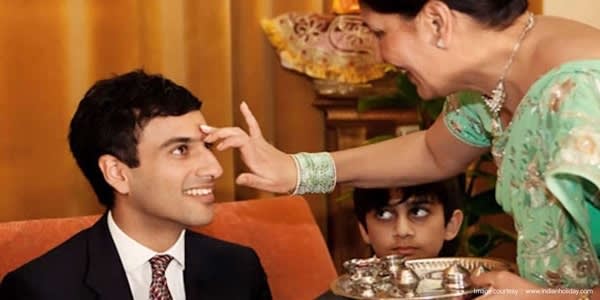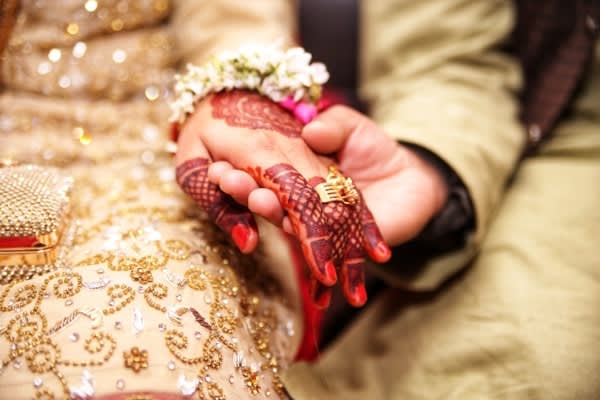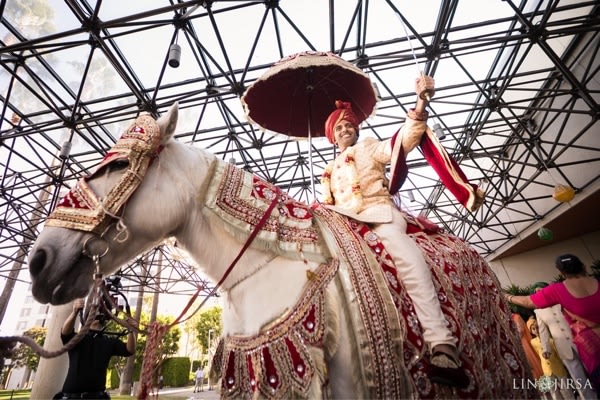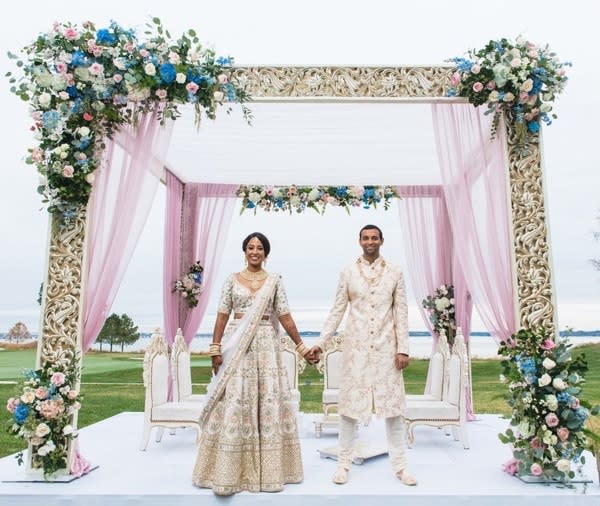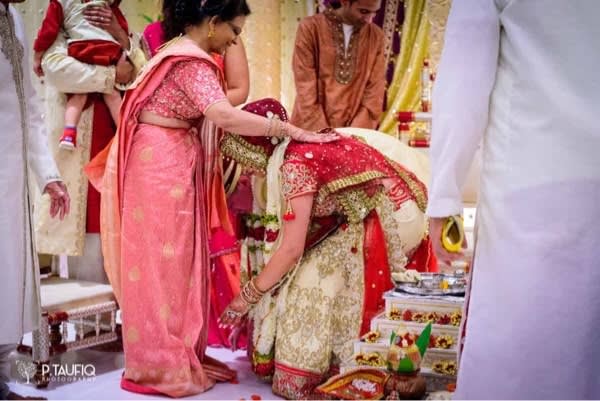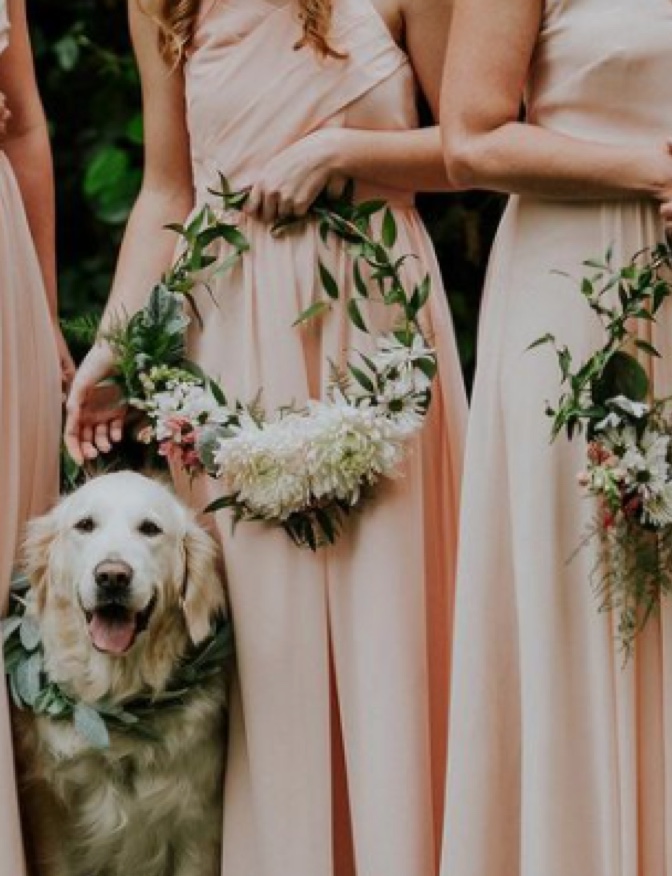When most people think of Indian weddings, they think of saris with vibrant colors, mehndi (or mehendi), beautiful jewelry, and elaborate ceremonies. While these are all part of Indian weddings, there are many other traditions that play a role in the celebration.
From ceremonial fires to the exchanging of gifts, these traditions add an extra layer of excitement to the big day (or days!). In this post, we’ll focus on some of the more common Indian wedding traditions.

Photo by Amrit Photography
Pre-Wedding Indian Wedding Traditions
The period leading up to Indian weddings is just as important as the wedding itself. In fact, many of the traditions take place during this time. Here are some common pre-wedding Indian traditions:
Determining the Muhurat: Auspicious Date & Time
The first step in any Indian wedding is to consult with a pandit or Hindu priest. Based on the couple's horoscopes, the pandit will help determine the “Muhurat” – the auspicious date and time for the wedding. This is an important step because it is believed that the wedding date and time can significantly impact the couple's future.
After the date and time have been set, it's time to send out the wedding invitations. In the old custom, the bride’s family pays for the wedding costs. In this case, the bride’s side would be in charge of coming up with the guest list and sending out the invitations.
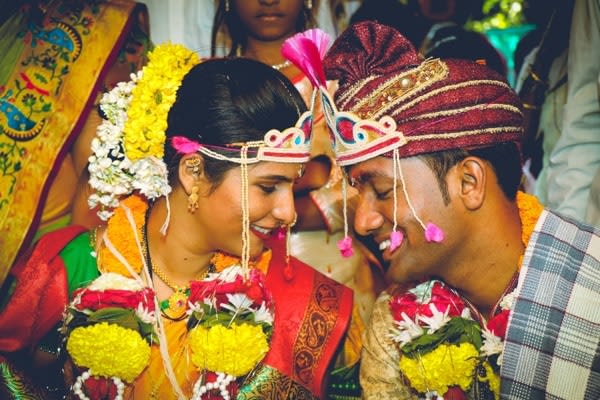
Today, the wedding is a celebration for both bride’s and groom’s families. Both sides will hand out invitations to their own guest list. Just like in American culture, it is customary to send out the invitations either by hand or through the mail.
The invitation suite often includes a list of all events that will take place during the wedding celebrations, similar to a wedding program, but more comprehensive and spanning multiple days.
Puja or Path – Prayers
Most weddings usually start their festivities with a religious ceremony at home or in a place of religious procession (a temple or gurudwara). “Puja” (Hinduism) or “Path” (Sikhism) means prayer offerings, and are often made to Lord Ganesh, the god of wisdom and salvation, and Lord Vruna, the god of Water.
Mehndi Party
An incredibly important event for the bride, the Mehndi party is usually held the night before the wedding. The bride gets her hands and feet decorated with beautiful Mehndi (henna) designs by professional mehndi artists, and her friends and family. These designs often take between four and ten hours to complete.
This event is usually a day before the wedding, since henna is usually brightest the day after an application. The bride will be careful not to submerge the henna in water so she doesn’t lose any color before the wedding.
This is a fun-filled event where the bride can relax and enjoy quality time with her friends, bridesmaids, and family. The Mehndi party celebrations traditionally involve singing and dancing in the bride's home.
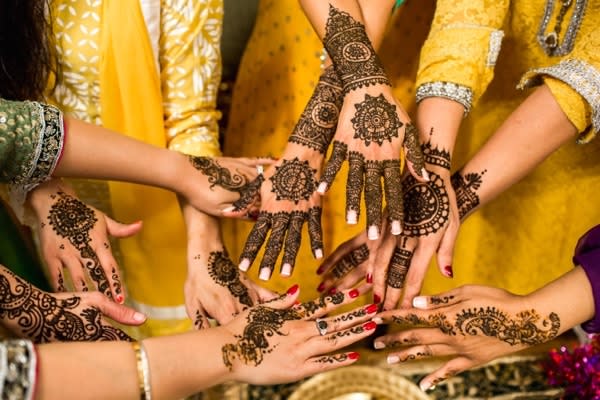
A Mehndi invitation card is included in the invitation suite to send out to the guests. At Minted, all South Asian invitations have matching Sangeet and Mehndi invitation cards. If there is another design that you like that does not come with matching designs, each enclosure card can be modified to fit your needs with the help of a dedicated designer.
Once you have selected your Invitation design, you can carry through your theme from the invitations & wedding websites to the day-of stationery with menu cards, table numbers, place cards, and programs that correspond to your invitation design.
Sangeet and Tilak Ceremonies
Sangeet means "to sing together.” It’s a musical party typically held the night before the wedding. Even though the bride and groom are already engaged, the actual exchange of rings happens the night before the religious wedding.
The evening starts with the Tilak ceremony, where religious prayers are shared and a red dot is placed on the groom's forehead by a family member (traditionally a maternal uncle). This red dot is called a tilak and is said to protect the groom from evil spirits.
Besides the religious prayer, an exchange of gifts between both sides of the families also takes place during this ceremony. Then, the family and friends prepare performances and/or skits full of singing and dancing to entertain the bride, groom, and guests.
This event is an excellent opportunity to let loose and have fun before the big day, and a chance for the families to get to know each other better. The evening usually ends with an open dance floor that can last until late into the night.
Like the Mehndi party, the Sangeet parties can have their own invitations too, since each are discrete events
Wedding-Day Indian Wedding Traditions
While the following are standard traditions on Indian wedding days, each culture within India has their own set of traditions depending on where you are in the country: North, South, East, or West.
No matter how many Indian weddings you go to, there is always a new tradition to witness, — part of what makes them such incredible and memorable experiences.
The Haldi Ceremony
The Haldi ceremony involves anointing the bride’s and groom’s skin with a paste of turmeric, sandalwood, and rosewater. It is traditionally believed that this paste will help them get rid of pre-wedding nerves and look their best on the big day.
Occurring the morning of the wedding, it’s a fun event with family members applying the paste on the bride and the groom – it can get messy! It lasts a few hours, is followed by lunch, and then families begin getting ready for evening festivities.
Traditionally, the ceremony is separate for the bride or groom since they’re not supposed to see each other until the wedding ceremony. Today this is followed less closely, and some brides and grooms decide to have a shared Haldi event.
Baraat & Kanya Aagaman – The Wedding Processions
The wedding procession, or Baraat, is the event that commences the start of the wedding and is one of the most important and exciting parts of the day. Traditionally, the groom arrives at the wedding venue on a decorated horse–or even an elephant–and it can take more than an hour. Nowadays, for practical reasons, some grooms opt to arrive in a flashy car, accompanied by his family and friends.
The groom’s side of the family is formally received by the bride’s side with garlands, lit candles, and vermillion bindis.
They may include the tradition where the groom pays money to his bride’s siblings and cousins to get into the wedding venue. Or the Joota Chupai custom, where the bride's sisters and female relatives steal the groom's shoes and demand a ransom for their return. The groom usually has to pay money or do a funny dance to get his shoes back after the ceremony. This playful tradition adds more light-hearted fun to the wedding festivities.
After the Baraat is received, the bride arrives at the mandap with her own procession of her parents, family, and close friends. During the bride’s arrival, or Kanya Aagaman, she is traditionally carried in a dolhi – which can range from a basic canopy or a highly ornate carriage – by her brothers and male cousins who also hold a large mesh of fresh flowers over her head.
Jai Mala – The Exchange of Garlands
This is more fun and games where the bride and groom exchange floral garlands – that represent commitment, happiness, and excitement – before the wedding ceremony officially begins. It happens on a stage different from the “mandap” (like an altar) where the religious ceremony will take place.
Like the rest of the wedding events, there is fun competition between the families during the Jai Mala. The groom’s side and bride’s side might playfully hinder the two while they’re trying to place the garlands on one another, and often they’re lifted off the ground to make it more difficult!
Pheras – The Ceremony Under the Wedding Mandap
After the garlands are exchanged and many photos are taken, the bride and groom proceed to the wedding mandap at the predetermined “mahurat.” (Depending on the mahurat the priest has determined, the ceremony could take time at any place during the day, so sometimes dinner is held before the Pheras.)
The wedding mandap is a special structure where the ceremony takes place. It’s usually decorated with flowers and sometimes has four pillars to symbolize the four stages of life according to Hindu Vedas.
The mandap is laid out as a square, with each side being occupied separately by the bride and groom, the parents of the bride, the parents of the groom, and the priest. In the center of the mandap is a small fire. The bride and groom will hold hands and walk around the lit fire four to seven times (Pheras) while they take their vows.
The priest here performs the “Puja” (prayers and rituals), with this part of the wedding lasting for a couple of hours or more, depending on specific subcultures. You’ll see both tears and smiles during this emotional time.
A critical point of the ceremony is when the groom places a line of “sindhoor” from the top of the forehead to the parting of her hair. This action marks the bride as a married woman. The Sindhoor is a vermillion or red-orange powder that’s mixed with some water to form a paste, and the line can be adorned with bindis or other decorative stones.
The groom will also tie a mangalsutra, or sacred necklace, around the bride's neck as a symbol of their marital status and commitment to each other. The mangalsutra is usually made of gold and has black beads.
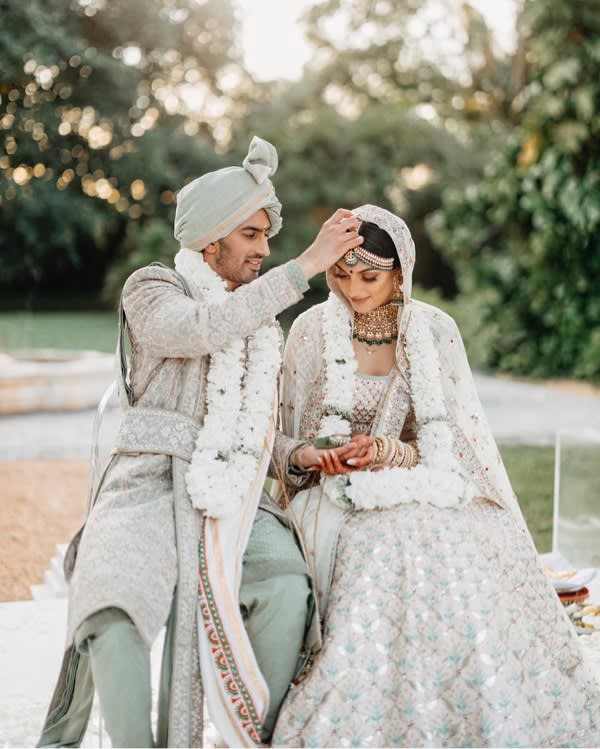
Photo by Amrit Photography
The Reception
After the ceremony, it's time to celebrate! The reception is a grand affair, with lots of food and dancing. The bride and groom usually make a grand entrance into the reception hall, where their guests greet them.
They take turns dancing with each other and with their families and friends. Guests bring gifts for the couple, usually placed in a special box at the reception, ranging from clothes to jewelry to money.
Indian weddings are traditionally huge, with hundreds or even thousands of guests. So be prepared for a big party!

The Food
Indian weddings are known for their fantastic food served buffet-style. There will be plenty of delicious dishes that are primarily vegetarian.
And make sure you save room for seconds! There are often many different kinds of desserts, such as jalebi (a sweet fried pastry) and gulab jamun (similar to fried donuts in sugar syrup).
While the core families eat after the phera ceremony, a large number of guests can eat from the buffet before the religious ceremony is over – especially since the mahurat can be at any time in the evening.
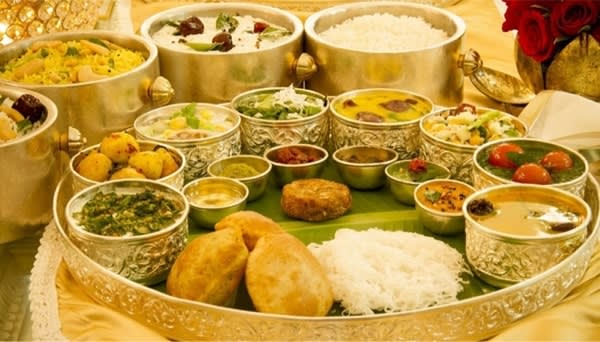
Post-Wedding Indian Wedding Traditions
Just because the wedding day is over doesn't mean the festivities are! There are still many traditions that take place after the wedding.
Aashirwad Ceremony
The Aashirwad ceremony is when the elders bless the couple and give them their best wishes for a happy and prosperous life together. This is usually done by the parents, grandparents, or other close relatives.
After the Aashirwad ceremony, it's time for the couple to leave for their new home! But before they do, the bride's mother will break a coconut at the doorstep. This is considered good luck for the newlyweds.
Vidaai
After this is the Vidaai, which is a very emotional moment for the bride and her family. It’s when the bride says goodbye to her family as she leaves to start her new life with her husband.
The bride will toss rice behind her as a sacred way to bless her family and thank them for all the years of nurturing. The Vidaai ceremony is often accompanied by tears, laughter, and lots of hugs and kisses as a happy ending to many beautiful events.
Indian Wedding Fashion
Indian weddings are a colorful and festive affair. And fashion is no exception! Below are some popular Indian wedding fashion trends
Brides
The popular choice for brides is a brightly colored sari (traditional clothing adorned by Hindu women draping across their chest and down their arms). Red is considered the luckiest color, but you'll often see brides wearing pink, orange, yellow, and other vibrant colors.
Another popular choice for brides is a lehenga. A lehenga is a long skirt paired with a blouse and dupatta (scarf) and are often brightly colored.
The sari or lehengas are usually adorned with embroidery and gold jewelry. The bride will also wear a bindi (a red dot) on her forehead and Mehndi (henna) on her hands and feet.
Brides often change into multiple outfits on the wedding day. So don't be surprised if you see a bride in a sari for the ceremony and then in a lehenga or salwar kameez for the reception!
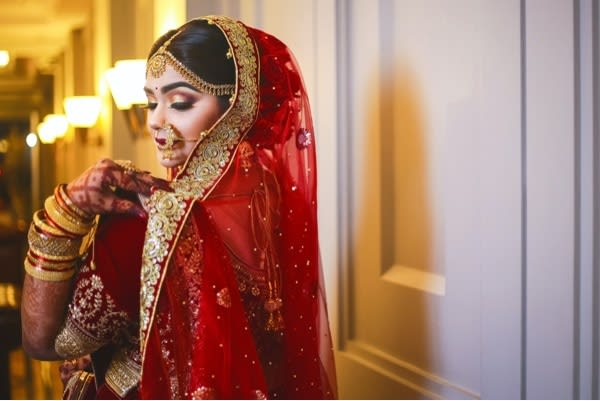
Grooms
For grooms, the popular choice is a sherwani. This is a long coat worn over a shirt and pants. The sherwani can be silk or cotton, embroidered embroidery, and gold buttons. The groom will also wear a turban.
Another option for grooms is kurta pajama. This is a loose-fitting shirt and pants outfit made of cotton or other lightweight fabrics. The kurta pajama can be plain or decorated with embroidery.
Grooms can also wear a dupatta (scarf) around their shoulders as well. Like brides, grooms often change into multiple outfits on the wedding day.
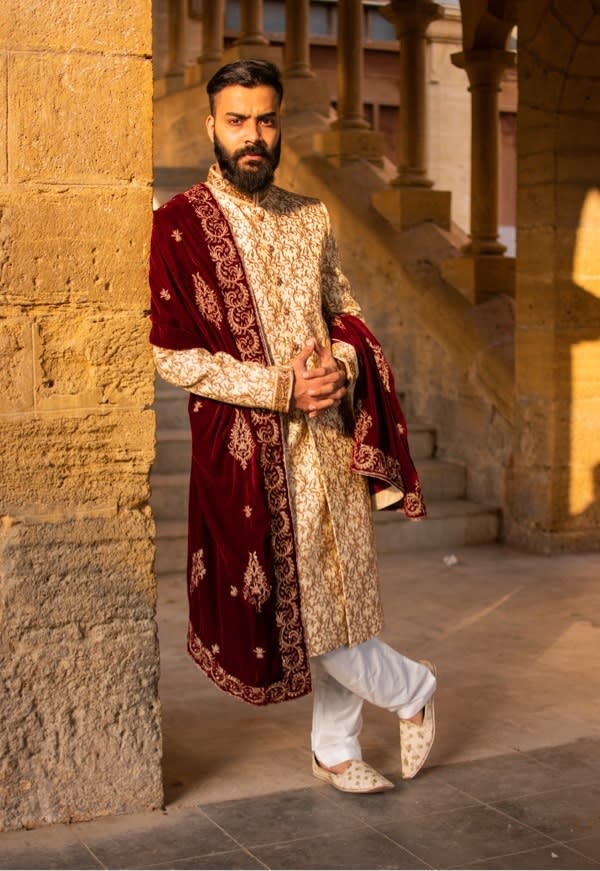
Wedding Parties
While traditionally there is no concept of matching outfits for bridesmaids and/or groomsmen, some modern Indian bride and groom usually choose coordinating colors for their wedding parties.
The popular choice of outfits for wedding parties is a brightly colored sari or lehenga.
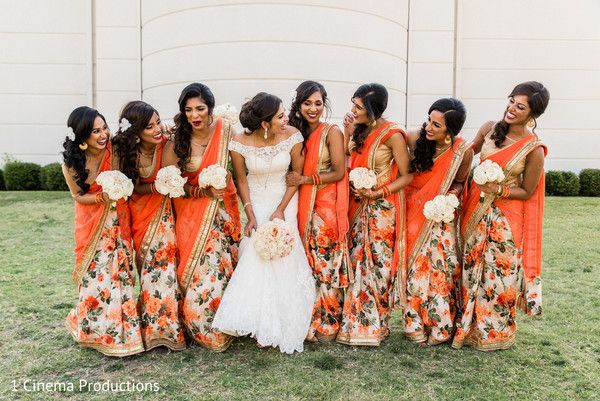
Guests
For wedding guests, women often wear sari, and men wear kurta pajama. If you have none of these, wearing Western clothing such as a suit or dress is perfectly acceptable.
Red is considered the luckiest color, so you may see many guests wearing red. The bride and groom themselves usually avoid white and black outfits since some believe those two colors bring bad luck. To be on the safe side, it is typical for guests to also avoid black and white outfits.
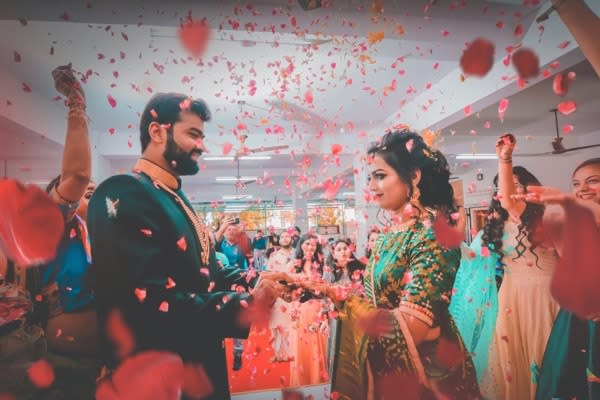
Modern Indian Wedding Traditions
While traditional Indian weddings are still very popular, you will also see many modern Indian weddings. These weddings often incorporate both traditional and modern elements. For example, the bride and groom may wear traditional Indian clothes for the ceremony but then change into Western attire for the reception.
Or, they may have a traditional Hindu ceremony but then have a Christian reception, if they are blending cultures. It's really up to the couple to decide how they want to incorporate cultural traditions into their wedding day.
Indian Wedding Traditions in America
Many couples who have Indian heritage choose to have an Indian wedding in America to ensure both families and friends can attend. If you're attending an Indian wedding in America, you can expect to see many of the same traditions as in India.
The bride and groom usually wear traditional Indian clothes, and the wedding party will also be dressed in traditional Indian attire. The ceremony will often be held at a temple or another religious venue, and the reception will usually include Indian food and music.
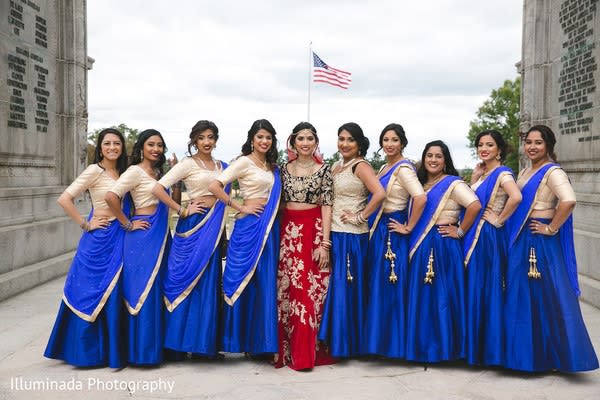
Indian Weddings Traditions vs. Hindu Wedding Traditions
It's important to note that not all Indian weddings are Hindu weddings. While Hinduism is the most common religion in India, many other religions such as Islam, Christianity, and Sikhism are also practiced in India.
Each of these religions has its own unique wedding traditions. For example, a Muslim Indian wedding may include a Nikah ceremony, while a Sikh Indian wedding will often include an Anand Karaj ceremony.
Hindu weddings also vary depending on what region of the country they’re in.
The beauty is that no matter how many Indian weddings you go to, there is always a new tradition to experience and enjoy.
Indian Wedding Traditions to Know
Baraat
Baraat is a ceremony in which the groom arrives at the wedding ceremony accompanied by his family and friends. The Baraat procession is often very festive, with music and dancing.
Haldi Ceremony
The Haldi ceremony is a pre-wedding ritual in which the bride and groom are covered in turmeric paste. This paste is said to have many benefits, such as making the skin glow and improving circulation.

Hasta Melap
Hasta melap is a ceremony in which the bride's and groom's hands are tied together. This symbolizes the couple's union and their commitment to each other.
Jai Mala
Jai mala is a ceremony where the bride and groom exchange flowery garlands. This is often done after the hasta melap ceremony.
Kanya Aagaman
Kanya Aagaman is the ceremony in which the bride arrives at the wedding venue. The groom's family welcomes her with flowers, and she is then escorted to the mandap, where the wedding ceremony will take place.
Mandap
Mandap refers to the structure that the bride and groom sit under during the wedding ceremony. This structure is often supported by four pillars and decorated with flowers and other decorations.
Mangala Sutra (Mangalsutra)
The mangalsutra is a necklace the groom ties around the bride's neck during the wedding ceremony. It is considered to be a symbol of love and commitment. The mangalsutra is usually made of gold and black beads and is said to protect the marriage from evil spirits.
Mehndi (Henna)
Mehndi is a paste made from the henna plant's leaves. It is used to decorate the hands and feet of the bride. The Mehndi ceremony is usually held a few days before the wedding and is considered a very important part of the wedding preparations.
Pheras
This is the religious ceremony where the bride and groom walk around a lit fire for four to seven rounds.
Puja
These are the prayers and rituals included in the wedding ceremony.
Roka
This is the official announcement of the relationship by the couple and their families. It may just be an announcement or include an additional event. Weddings often happen within a year from this announcement.
Vidaai
After the wedding is over, the bride bids goodbye to her family and leaves with the groom amid many tears, hugs, and kisses.








